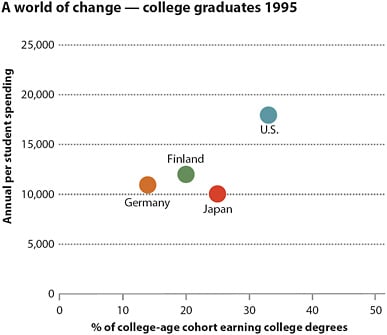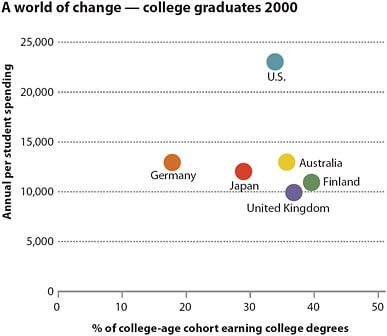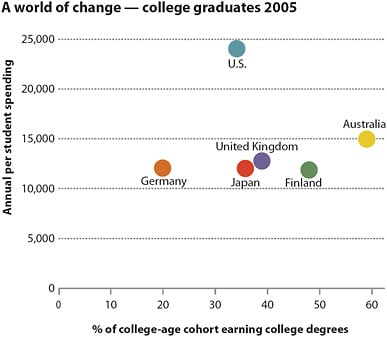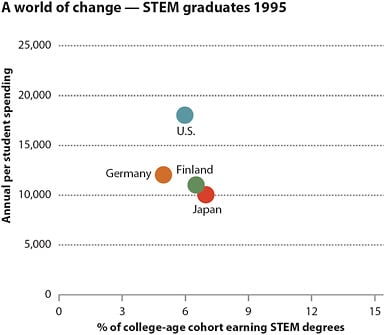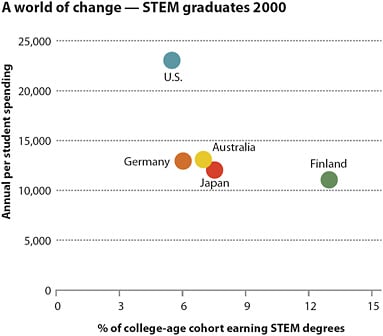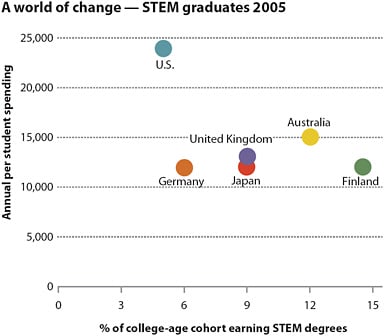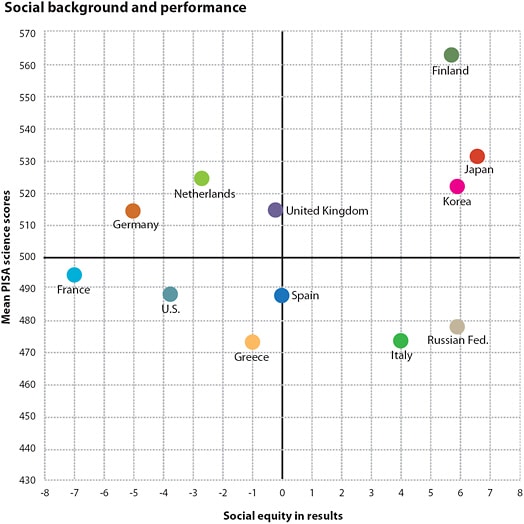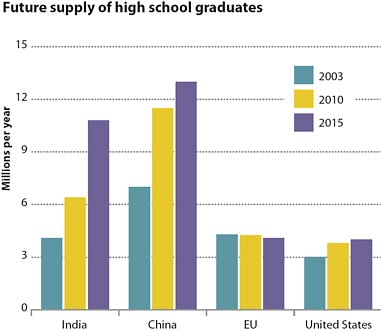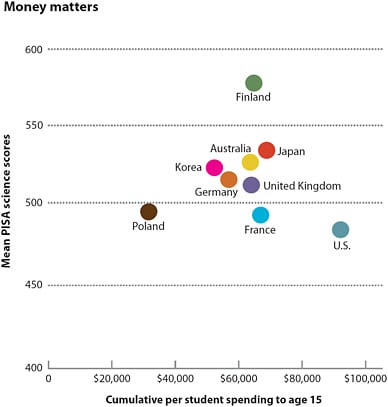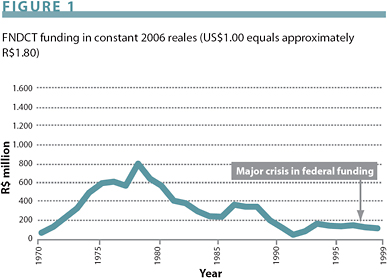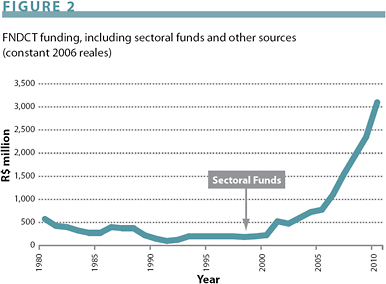Science and the Entrepreneurial University
During the second half of the 20th century, research universities in the United States remade themselves into an important engine of the modern economy. Everyone has heard of the technological miracles wrought by Silicon Valley in California and Route 128 in Massachusetts. Less well known is that high-technology activity, much of it stimulated by research institutions, is estimated to account for 65% of the difference in economic growth among U.S. metropolitan regions, according to a new book by sociologist Jonathan R. Cole of Columbia University, The Great American University: Its Rise to Preeminence, Its Indispensable National Role, Why It Must Be Protected. Further, 80% of leading new industries may derive from university-based research. Although research universities represent only a small fraction of the higher-education system—fewer than 200 of over 4,000 postsecondary institutions—they are now recognized as essential to U.S. economic leadership.
Yet this is not a moment for self-congratulation. The U.S. economy is beset with difficulties, and as a result universities, especially public universities, are experiencing a painful disequilibrium of their own. Today’s climate of economic dislocation is reinforcing the pressures on research universities to play a more direct and active role in fostering innovation than ever before. Can they do it? The short answer is a conditional yes. But the nation faces several key challenges in making that happen.
In looking ahead, it is first useful to recognize four broad developments that have shaped the role, distinctive to the United States, of research universities in the economy. These developments are:
- The historic decision to establish a comprehensive federal policy on the role of science in the post–World War II era. This policy, in large part the creation of President Franklin Roosevelt’s science adviser Vannevar Bush, was embodied in Bush’s 1945 report Science, The Endless Frontier.
- The 1980 Bayh-Dole Act, which allowed universities to keep the patent rights to inventions resulting from federally funded research at their institutions.
- Economic analyses that have validated the central role of knowledge in economic growth, influencing both government and university policy on industry/university partnerships.
- Current experiments with new forms of industry/university collaborative research.
The postwar paradigm
Vannevar Bush’s historic report grew out of the pivotal contributions that science and engineering had made to the U.S. effort during World War II. This effort required Bush and his colleagues to organize scientists and engineers to work toward a common goal on a scale never attempted before, and he and President Roosevelt feared the gains would be lost without deliberate policies: a blueprint for supporting science in the postwar world. Bush’s intention was to provide industry and the military with a permanent pool of scientific knowledge to ensure economic growth and defense. His strategy was to define the different roles of government, industry, and universities in the scientific enterprise.
The federal government’s role would be to support basic science generally, not its applications. Industry would be responsible for applied research. Bush reasoned that industry had little incentive to invest heavily in basic research because its results were not proprietary and might be profitably applied by rival firms. Research universities, he decided, should be responsible for producing the pool of fundamental knowledge on which industry could draw. Federal support for university research would be channeled through a system of grants to individual researchers. Each grant would be awarded to projects whose scientific merit had been endorsed through a process of peer review. Congress established the National Science Foundation (NSF) in 1950 to serve as an independent federal agency devoted to supporting basic research and education in all scientific and engineering disciplines.
The most far-reaching premise of Bush’s report was never explicitly stated in that document. In arguing for the primacy of basic research, Science, The Endless Frontier defined the national research system as residing in its research universities, the locus of most basic scientific research and all graduate and postgraduate education in the United States. Before World War II, the federal government provided virtually no support for research in universities; the very concept of such funding was viewed as a radical idea. In the postwar world, the government committed itself to becoming the major sponsor of scientific research in universities. It was an extraordinary reversal of direction.
Bush’s model—a national scientific enterprise in which basic research, supported with federal funds and conducted by universities, would be implemented by private industry—was a highly simplified version of what actually happens in the discovery and application of new ideas. But his enduring accomplishment was to create a vast system of scientific and technological research organized to produce regular and systematic innovation in the service of economic growth and national security. This is why Science, The Endless Frontier remains to this day the single most important document on U.S. science policy ever written.
Tweaking the paradigm
Vannevar Bush’s report was a landmark of federal policymaking, but by the 1970s the innovative engine it created seemed in need of repair. Strong competition from a reinvigorated Europe and Asia, declining U.S. productivity growth, and rising unemployment made economic competitiveness a major national preoccupation. U.S. universities were producing a rich array of potentially useful research, but innovations were not moving into the private sector as quickly or efficiently as the economy required. The weak link in Bush’s model was at the point of transfer from the public to the private sector. The search for better, faster, and more efficient ways of moving university discoveries to market was under way.
The new urgency surrounding technology transfer was in part an unintended consequence of Bush’s report. University research partnerships with industry had flourished in the early years of the 20th century. But these partnerships dimmed in the years after World War II, eclipsed by the sheer volume of federal research funding that poured into research universities in the 1950s and 1960s.
The U.S. government embarked on a series of actions to rebuild the nation’s competitiveness during the 1970s. This plan included diverse actions such as establishing tax credits for research, funding public/private research centers, and easing antitrust regulations to encourage research partnerships. For universities, the most far-reaching of these actions was the Patent and Trademark Amendments of 1980, better known as the Bayh-Dole Act. Bayh-Dole was intended to invigorate the technology transfer process from universities and federal laboratories to business and industry. It accomplished this through a fundamental shift in government patent policy.
Before the 1980 legislation, the federal government owned the rights to any patentable discovery coming out of research supported with federal funds. Yet few research results ever made it to market under this arrangement. Bayh-Dole transferred government’s patent rights to universities, leaving it to each institution whether income derived from a patented invention went to individual researchers or the university, or was shared by both. Although the result was to open a new income stream for universities, this was secondary to Bayh-Dole’s primary aim: to see that the public investment in basic research served national economic growth.
The influence of Bayh-Dole has been profound, making it far more attractive for universities and industry alike to partner in the commercialization of scientific discoveries. Between 1988 and 2003, U.S. patents awarded to university faculty increased fourfold, to 3,200 from 800. Technology transfer offices on research university campuses are now ubiquitous. Most patent income flows from a few hugely successful discoveries, such as the basic technique for DNA recombination or, more recently, the development of pioneering new drugs. Not all technology transfer offices make money, and only a few make a great deal. Nonetheless, they are key organizations on university campuses, because they offer a ready means for faculty to move research results into the commercial sector.
Thirty years after the passage of Bayh-Dole, some critics complain that universities still do not do enough active technology transfer, either sitting on patents they own or demanding unrealistic value for proprietary rights to university inventions. One proposed solution would allow faculty members to bypass campus technology transfer offices entirely and negotiate their own licensing agreements. From the outset, a broader objection was that Bayh-Dole would be a step down the road to transforming research universities into job shops for private industry, a threat to the integrity of their research and educational missions. This has occurred in some cases when universities have conducted proprietary research funded by industry. The more common experience, however, is that universities and their industrial partners have managed to negotiate successful research arrangements that respect their differences in mission and culture.
Validating new knowledge
NSF was very much involved in the activities generated by the competitiveness crisis of the 1970s. NSF began an analysis of the technology transfer process and, based on its findings, prepared the legislative draft bill that laid the foundations for the Bayh-Dole Act. It also examined other incentives for investing in research, such as tax credits and industry/university partnerships. These studies led NSF to establish the Industry-University Cooperative Research Program, which supported joint research projects between industry and universities. Industry was responsible for funding its part of the project and NSF funded the university side. The program was novel at the time and created some concerns in the research community. But the quality of the proposals and the excellence of the work quickly established the value of the program, and it now has been replicated at other agencies. NSF also established an extramural research program, funding projects to study the relationship between investments in R&D and various types of economic growth.
Economists have long recognized that new inventions and techniques can spur economic growth and productivity. But for many years, most members of the profession assumed that new technology was less important than labor and capital in driving economic growth. In the 1950s, Robert Solow of the Massachusetts Institute of Technology challenged this view with a mathematical model demonstrating that only half of economic growth can be traced to labor and capital. The remainder, he argued, was due to technical progress.
But relatively little quantitative work on exactly how R&D connects to the economy had been done at the time NSF launched its studies in the 1970s. Edwin Mansfield, an economist at the University of Pennsylvania and an important contributor to these studies, coauthored a landmark 1977 paper on the social and private rates of return on industrial innovations; that is, the benefits that private firms gain from investing in new products and processes as compared to the benefits that accrue to society. Mansfield and his colleagues found that the social rate of return was much higher than the rate of return to the firms themselves. The paper provided empirical evidence for Vannevar Bush’s argument that private industry has little financial incentive to invest in basic research, which should instead be supported by government as a public good.
Toward the end of his career, Mansfield turned his attention to how basic research in universities stimulates technological change. He wrote an influential 1995 paper assessing how academic research contributed to industrial innovation in 69 firms in seven major and diverse manufacturing areas, including information processing, pharmaceuticals, and petroleum. Mansfield found that academic research was responsible for about 11% of the new products and about 9% of the new processes in the companies he studied. His analysis was a systematic attempt to document the sources, funding, and characteristics of academic research that yields industrial applications. This and many other Mansfield studies helped shape government policy on technology and economic growth. Later studies have provided further evidence of Mansfield’s thesis that publicly supported research is a significant source of industrial applications. A 1997 analysis of U.S. industrial patents found that 73% of the papers cited were written by researchers at publicly funded institutions (universities, government laboratories, and other public agencies) in the United States or foreign countries.
Another development, New Growth Theory, has translated broad intuitive ideas about innovation and economic growth into explicit and elegant mathematical models. Stanford University economist Paul Romer has been a major figure in this domain. His seminal 1990 paper, Endogenous Technological Change, begins with a question: Why has U.S. productivity—output per worker per hour—increased 10-fold over the past century, whereas conventional economic theory would lead to an expectation that growth would peak at some point and then level off or decline?
Romer’s answer: technological change. The example he gives is iron oxide. A century ago, the only way to elicit visual pleasure from iron oxide was to use it as a pigment. Today, it is applied to plastic tape to make videocassette recordings. Incremental improvements such as these lie “at the heart of economic growth,” according to Romer, and in this respect his model resembles Solow’s. Technical progress occurs at an increasingly rapid rate because successive generations of scientists and engineers learn from the accumulated knowledge of their predecessors. Further, technological change is driven, in large part, by market incentives. Even if you are a professor on a federal grant with no interest in applying your discoveries, should commercialization occur it will be because an individual or a private firm wants to make a profit. This is why Romer describes technological change not as some external quantity injected into economic activity, but as something endogenous—internal—to the economic system itself. Unlike land, labor, and capital, technological change created by human ingenuity holds out the potential of ever-increasing expansion in the wealth of nations. “The most interesting positive implication of the model,” he concludes, “is that an economy with a larger total stock of human capital will experience faster growth.”
New Growth Theory and subsequent economic and management analyses have provided a greater degree of sophistication in ideas about how the economic innovation process works; society now has a more complex understanding of the relationship between discovery and application than the 1945 Bush model affords. Recent scholars have emphasized the central role of entrepreneurship and the individual entrepreneur in this process. Of particular note, Lynne G. Zucker and Michael R. Darby of the University of California, Los Angeles, have looked at the origins of the first U.S. biotechnology companies. They found that the active, hands-on involvement of “star” scientists—scientists who had made original discoveries in the field and understood how to apply techniques of working with recombinant DNA—was indispensable to the early expansion of the biotechnology industry. In biotechnology and certain other fields, the leap from basic science to innovative product is short and getting shorter.
Carl Schramm and Robert E. Litan of the Kauffman Foundation argue that small entrepreneurial companies are key to pulling the United States out of the current recession. Between 1980 and 2005, firms less than five years old were responsible for almost all of the 40 million net new jobs (the jobs left after subtracting positions eliminated by downsizing) created nationwide. In this light, the United States should be creating an environment that is favorable to entrepreneurship generally, but especially to small discovery-based companies. These companies have the capacity not only to grow quickly and generate jobs. They also become the means of spreading transformative innovations, such as the automobile or Internet search engines, that have a deep influence on national prosperity over the long term.
The economic importance of entrepreneurs, startups, and small companies has not been lost on state and local governments, many of which are working directly with universities to advance regional economic growth. A California example is the CONNECT program, initially established at the University of California, San Diego, and now an independent nonprofit agency. As its name implies, CONNECT brings together university researchers with entrepreneurs, angel investors, and venture capitalists from around the country. It has helped launch hundreds of successful startup companies in the San Diego area.
CONNECT and similar efforts reflect the competitive realities of the national and global marketplace and the new demands they are bringing to research universities. One is the demand for more, and more interdisciplinary, research, conducted with industrial partners to help translate basic science into new products, processes, and startup companies. Another is the expectation that research universities will make explicit efforts to take a longer view about the scientific and technological discoveries that will prove essential to the economy 10 or 20 years down the road. A third is that they will educate students who are proficient not only in science and technology but also in entrepreneurship. Some of these goals can be accomplished using the traditional methods and approaches employed in research universities. But others will require a shift in some longstanding attitudes and assumptions about conducting scientific investigation and working with industry. Research universities, in other words, are being asked to become more entrepreneurial themselves.
Promoting a new model
One of the clearest illustrations of this trend is a California initiative to create the next generation of industry/university research partnerships. In 2000, Gray Davis, then the state’s governor, announced four new interdisciplinary research institutes on University of California (UC) campuses, to be chosen by a competitive process and funded through a three-way partnership among government, industry, and the university system. The California Institutes for Science and Innovation conduct fundamental and applied research across many disciplines to achieve the scientific breakthroughs and new technologies that will drive the state’s economy and improve its society. Educating future scientific leaders is part of their mandate as well, which means that students participate in all phases of research. Each institute involves two or more campuses, with one campus taking the lead. The institutes are:
- The California Institute for Telecommunications and Information Technology, with UC San Diego as the lead campus, in partnership with UC Irvine.
- The California Institute for Quantitative Biosciences, with UC San Francisco as the lead campus, in partnership with UC Berkeley and UC Santa Cruz.
- The California Nanosystems Institute, with UCLA as the lead campus, in partnership with UC Santa Barbara.
- The Center for Information Technology Research in the Interest of Society, with UC Berkeley as the lead campus, in partnership with UC Davis, UC Merced, and UC Santa Cruz.
Each institute collaborates with a variety of researchers, students, and private companies. State government contributed $100 million in capital support for each institute, with the requirement that the institutes raise matching funds on a two-to-one basis to the capital funds. Today, the state provides $4.75 million annually in operating funds, and the university system provides $5.25 million. The rest of the institutes’ support comes from federal grants and industry partnerships.
An inspiration for the California institutes was the renowned corporate research giant AT&T Bell Laboratories, responsible in its heyday for such key scientific advances as the transistor and fiber optics. The era of the big industrial laboratories (Xerox and RCA as well as Bell Labs) is over. But a key lesson of Bell Labs’ phenomenal success was the utility of scale in making rapid progress toward the solution of large scientific or technical questions. Whereas other research enterprises might have a dozen or more scientists focused on a particular problem, Bell Labs could marshal hundreds. What if a series of laboratories were created within the UC system, staffed by a critical mass of researchers from many disciplines, institutions, and industries, all dedicated to creating the scientific discoveries in major fields required for the economic and social prosperity of California?
In part, the California institutes are an effort to repair the weak link in the 1945 Bush model: technology transfer. In part, they are one state’s answer to the innovative vacuum left by the decline of the great industrial laboratories. But they also are an experiment in creating a new research model. This model goes well beyond technology transfer to a closer integration of universities and industry. Its most important assumption is that innovation will be faster and better in institutions that can successfully draw on the different strengths of academic and industrial science.
An example: The California Institute for Telecommunications and Information Technology (more conveniently called Calit2) focuses on the innovative potential of the continual exponential growth of the Internet and telecommunication. Calit2 provides advanced facilities, expert technical support, and state-of-the-art equipment: an environment intentionally designed to allow researchers to work in new ways on new kinds of projects. Fiber-optic cables link the institute to research centers throughout California and around the world.
Most of the space in Calit2 is open, with few private offices. Media artists, cognitive scientists, computer engineers, biochemists, and medical doctors are not normally found working together. At Calit2, it is an everyday occurrence. Most projects last three to five years; some of the technologies being explored will take more than a decade to develop, others a year or so. At any particular moment, there are some 30 grant-funded projects under way. As soon as one project is completed, another takes its place, as researchers rotate in and out of their academic departments.
Calit2’s unique organization and world-class facilities enable it to shift focus rapidly in accord with the research goals of faculty and of private industry. The institute has worked with more than 200 firms, from startups to established giants, to provide them with many services they cannot produce themselves in a cost-efficient fashion. Sometimes a company wants to support a specific project or have a device tested. Or it may choose to invest in longer-term research and so funds a chair in that area, and later hires a graduate student mentored by the faculty member who held the chair. Other companies may establish corporate sponsorships that bring together researchers to think about the most fundamental of problems. Seven Hollywood studios have joined the Calit2 CineGrid project, which conducts experiments in its state-of-the-art, optical fiber–linked visualization facilities. Ten years after its founding, Calit2 is a leader in the fields of green technology, information theory, photonics and optical networks, digital biology, and technologies that integrate art, science, and computer sciences.
Collectively, the California institutes have received high marks to date for the innovative importance of their research accomplishments. Their progress toward the goal of creating the technological infrastructure for the next economy is harder to assess and perhaps premature. At the moment, their most pressing problem is operating funds. Although they have more than succeeded in attaining a two-to-one match for state funds, the Great Recession has left California on the edge of a fiscal precipice.
Need for institutional change
The new research model envisioned for the California institutes required a profound institutional change within the university system itself. One of the institutes’ most striking aspects is the way they are shifting traditional academic boundaries. The co-location of researchers from university, industry, and public agencies (the institutes work on societal challenges as well as economic ones) generates a dynamic environment for thinking about old problems in new ways. It has also created new kinds of learning and career opportunities for students. The institutes are a magnet for both undergraduate and graduate students interested in combining traditional in-depth knowledge of a single field with broad experience of one or two other fields as well. Business students seeking an education in entrepreneurship and innovation find the institutes a rich source of ideas, advisors, and research mentors.
The cross-disciplinary mandate of the institutes has required them to challenge the faculty specialization and physical isolation within a department that are typical of research universities. Calit2, for example, achieved its leadership in taking Internet technologies to the next level because 24 academic departments work across disciplines to tackle complex problems, many of which lead to the movement of intellectual discoveries into the marketplace. The institutes’ state-of-the-art facilities do more than enable state-of-the-art research. They create an experimental laboratory of innovation that is open to a broad cross-section of individuals and institutions, whether public or private, profit or nonprofit.
The future of innovation
Research universities are one of the best reasons why the United States can have confidence in its economic future. But they are under threat, and that is why the question of whether they will succeed in contributing more to economic growth must be answered with a conditional rather than an unconditional yes. It goes without saying that research universities must have more state and federal funding as soon as budgetary realities allow—if not before. They are facing other important challenges as well. To mention a few:
- Even before the Great Recession, funding increases for academic research were skewed toward just a few fields, principally the health and biological sciences and engineering. The nation has been underinvesting in the physical sciences; the earth, atmospheric, and ocean sciences; and the social sciences. This imbalance has been exacerbated by earmarking. Although the annual total of such appropriations is small compared to other kinds of congressional earmarks, the practice damages the peer-review process that has been a cornerstone of the research university system.
- In recent years, the level of all federal research funding for universities has increased very slowly. Most contracts and grants do not include sufficient support to recruit graduate students in the numbers we need for national economic competitiveness in key industries or to provide enough postgraduate fellowships. Federal funding constraints have imposed an especially heavy burden on younger faculty members. The overall success rate for proposals submitted to NSF is approximately 30%; the success rate for proposals from newly appointed Ph.D.s is closer to 20%. The fierce competition for funding may discourage faculty, including younger faculty, from submitting proposals that are out of the mainstream and could yield major breakthroughs.
- The federal government should make it easier for foreign-born students who have earned advanced degrees at U.S. universities to stay in this country after their education is finished. According to research by AnnaLee Saxenian, professor and dean of the UC Berkeley School of Information, and her colleagues, one-quarter of all engineering and technology firms established in the United States between 1995 and 2005 had at least one immigrant founder. A follow-up study revealed that over half of the immigrants who had started engineering and technology companies had received their highest degrees at U.S. universities. The United States has a record of integrating foreign-born students into its science and technology system that few other nations can match. The nation should build on that foundation even as it steps up efforts to recruit more U.S.-born students into scientific and technological fields.
State and federal policies have encouraged universities to become more active in the development of human capital, entrepreneurship, and industry/university collaboration. Economic analyses have given this trend a theoretical and empirical framework and made a compelling case for the benefits to society. Above all, it would be hard to overestimate the transformative influence of Vannevar Bush and his sweeping redirection of U.S. science policy. In making research universities the core of the U.S. system of scientific and technological innovation, he set them on the path to their current, and still evolving, role in economic growth. The age of the entrepreneurial university has only begun.


 This isn’t just a sensible idea; it’s the law of the land. In fact, the federal regulations don’t even consider this to be research involving human subjects. It is exempt from the federal rules, requiring neither review by an institutional review board (IRB) nor consent from the patient.
This isn’t just a sensible idea; it’s the law of the land. In fact, the federal regulations don’t even consider this to be research involving human subjects. It is exempt from the federal rules, requiring neither review by an institutional review board (IRB) nor consent from the patient.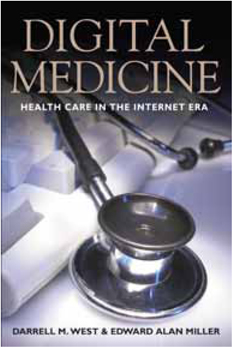 But just how typical am I, and what are the trends that will increasingly determine how patients, physicians, other health professionals, and provider organizations will embrace and adopt such technologies in the years ahead? West and Miller provide some answers to such questions in a fascinating monograph that appeared in mid-2009, much of it summarizing and interpreting the results of their national e-health public opinion survey that polled by telephone 1,428 adults from across the United States in November 2005. West is a political scientist from the Brookings Institution who collaborated with Miller, a faculty member at Brown University with expertise in public policy, political science, and community health. Thus, the book is written not from the perspective of the technology per se but as an exploration of the current trends in adoption, acceptance, and pursuit of e-health solutions in the United States and abroad. Taken together, the eight chapters survey a variety of key issues that have determined the rate and degree of e-health penetration, the attitudes toward the technology and to medicine in general, and the differences among individuals based on variables such as education, economic status, access, ethnic background, age, and gender. By assessing other data from studies throughout the past decade, the authors are also able to give us a sense of the trends in many areas—trends that generally show a significant change in the rate of adoption of e-health solutions both by providers and by the public. Thus the data summarized in the volume, while often useful and sometimes surprising, beg the question of how much the situation may have changed by today, some three or four years later.
But just how typical am I, and what are the trends that will increasingly determine how patients, physicians, other health professionals, and provider organizations will embrace and adopt such technologies in the years ahead? West and Miller provide some answers to such questions in a fascinating monograph that appeared in mid-2009, much of it summarizing and interpreting the results of their national e-health public opinion survey that polled by telephone 1,428 adults from across the United States in November 2005. West is a political scientist from the Brookings Institution who collaborated with Miller, a faculty member at Brown University with expertise in public policy, political science, and community health. Thus, the book is written not from the perspective of the technology per se but as an exploration of the current trends in adoption, acceptance, and pursuit of e-health solutions in the United States and abroad. Taken together, the eight chapters survey a variety of key issues that have determined the rate and degree of e-health penetration, the attitudes toward the technology and to medicine in general, and the differences among individuals based on variables such as education, economic status, access, ethnic background, age, and gender. By assessing other data from studies throughout the past decade, the authors are also able to give us a sense of the trends in many areas—trends that generally show a significant change in the rate of adoption of e-health solutions both by providers and by the public. Thus the data summarized in the volume, while often useful and sometimes surprising, beg the question of how much the situation may have changed by today, some three or four years later. But cars are not going away. More than 1 in 8 workers in the United States depend on the car, directly or indirectly. And most Americans continue to strongly resist alternative modes of travel, even though many endure long and frustrating commutes.
But cars are not going away. More than 1 in 8 workers in the United States depend on the car, directly or indirectly. And most Americans continue to strongly resist alternative modes of travel, even though many endure long and frustrating commutes.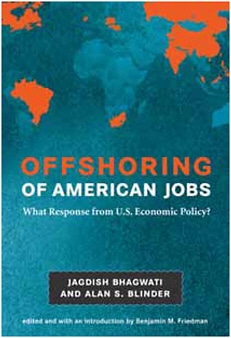 One might think that these challenging topics would easily be enough to fill 144 pages, and indeed they certainly could have. But some of the authors also see fit to exchange insults, pursue diversions, and engage in speculation. The volume thus provides an interesting window into the internal workings of the discipline of economics as well as a few insights into its main subjects.
One might think that these challenging topics would easily be enough to fill 144 pages, and indeed they certainly could have. But some of the authors also see fit to exchange insults, pursue diversions, and engage in speculation. The volume thus provides an interesting window into the internal workings of the discipline of economics as well as a few insights into its main subjects. Brian Arthur is a technophile’s technophile, an accomplished interdisciplinary scientist with degrees in, among other things, electrical engineering, operations research, math, and economics. He is well regarded for his work on the economic theory of increasing returns, which examines how small occurrences (such as the famous example of how the slightly longer capacity of VHS tapes enabled them to triumph over Betamax tapes in the dawn of the consumer videotape industry) can be magnified by positive feedback into large differences; and as one of the fathers of complexity theory, which argues for the desirability of studying complex systems in order to discover “emergent properties,” even if the discipline has come up with little in the way of tools for doing so. He has a strong relationship with the technophile world through his affiliations with Stanford University, the Palo Alto Research Center (PARC), and the mountain fortress of technophilia, the Santa Fe Institute. As John Seely Brown of PARC fame says on the cover of the book, “Hundreds of millions dollars slosh around Silicon Valley every day based on Brian Arthur’s ideas.”
Brian Arthur is a technophile’s technophile, an accomplished interdisciplinary scientist with degrees in, among other things, electrical engineering, operations research, math, and economics. He is well regarded for his work on the economic theory of increasing returns, which examines how small occurrences (such as the famous example of how the slightly longer capacity of VHS tapes enabled them to triumph over Betamax tapes in the dawn of the consumer videotape industry) can be magnified by positive feedback into large differences; and as one of the fathers of complexity theory, which argues for the desirability of studying complex systems in order to discover “emergent properties,” even if the discipline has come up with little in the way of tools for doing so. He has a strong relationship with the technophile world through his affiliations with Stanford University, the Palo Alto Research Center (PARC), and the mountain fortress of technophilia, the Santa Fe Institute. As John Seely Brown of PARC fame says on the cover of the book, “Hundreds of millions dollars slosh around Silicon Valley every day based on Brian Arthur’s ideas.” Callahan’s main focus is not technology per se but rather the evolution and prospects of the U.S. health care system as a whole. The challenge is formidable because the starting point is “a messy system, one ill-designed for reform because of the accretion of assorted interest groups with different agendas and vested interests, an ideologically divided public, and a steady stream of new and expensive technologies added to those already in place.”
Callahan’s main focus is not technology per se but rather the evolution and prospects of the U.S. health care system as a whole. The challenge is formidable because the starting point is “a messy system, one ill-designed for reform because of the accretion of assorted interest groups with different agendas and vested interests, an ideologically divided public, and a steady stream of new and expensive technologies added to those already in place.” The big questions about Google’s future spring partly from the giant’s beginnings, and Ken Auletta’s Googled: The End of the World as We Know It is a searching and well-informed probe into both. For added measure, the book is also a platonic love story and a moral tale.
The big questions about Google’s future spring partly from the giant’s beginnings, and Ken Auletta’s Googled: The End of the World as We Know It is a searching and well-informed probe into both. For added measure, the book is also a platonic love story and a moral tale.
